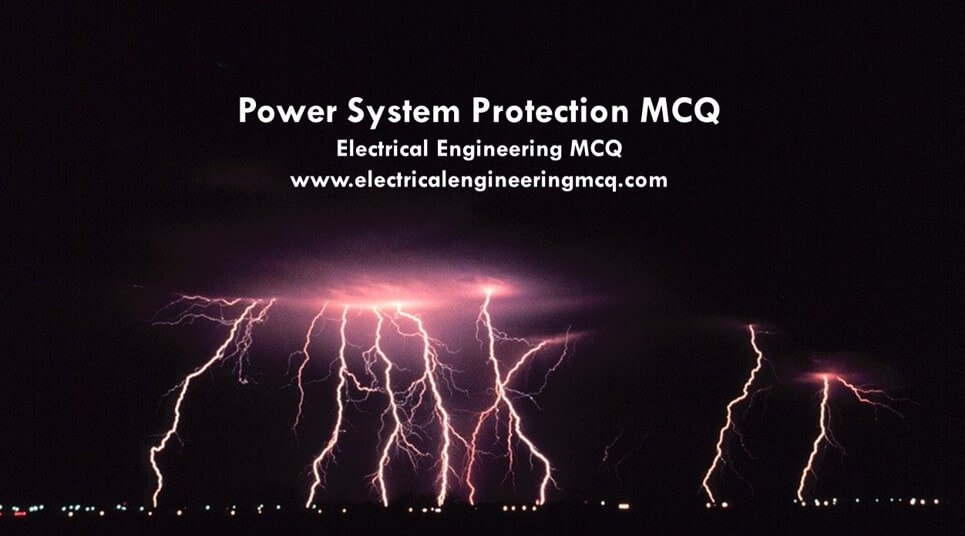Power System Protection is focused on the implementation of schemes and procedures for protecting electrical power systems against faults.
The most dangerous fault
The most dangerous fault:
- 3 phase fault
- Line to line fault
- Line to ground gault
- Double line to ground fault
Correct answer: 1. 3 phase fault
Heavy current fuses have wires that are in diameter than smaller ones
Heavy current fuses have wires that are _________ in diameter than smaller ones:
- Larger
- Smaller
- Same
- Any of above
Correct answer: 1. Larger
The pickup current of a relay having 125% current setting connected to 100/5 transformer is
The pickup current of a relay having 125% current setting connected to 100/5 transformer is:
- 1 Amp
- 5 Amp
- 6.25 Amp
- 10 Amp
Correct answer: 3. 6.25 Amp
Which device signals the circuit breaker in case of fault
______________ signals circuit breaker in case of fault:
- Fuse
- Isolator
- CT
- Relay
Correct answer: 4. Relay
Buchholz relay is used for protection of
Buchholz relay is used for protection of:
- Busbar
- Transformer
- Alternator
- Motors
Correct answer: 2. Transformer
While short-circuit test on circuit breaker a protection engineer obtained following readings on single frequency transient
While short-circuit test on circuit breaker a protection engineer obtained following readings on single frequency transient:
Time to reach the peak re-striking voltage = 50 µsec
Peak re-striking voltage = 150 kV
The average RRRV is:
- 2.5 kV/µsec
- 5 kV/µsec
- 10 kV/µsec
- 50 kV/µsec
Correct answer: 5 kV/µsec
Formula Hint: Average RRRV = Peak restriking voltage/Time to reach peak value
What is the approximate value of the contact resistance of circuit breaker
What is approximate value of the contact resistance of circuit breaker:
- 25 µΩ
- 25 mΩ
- 25 Ω
- 250 Ω
Correct answer: 1. 25 µΩ
Important Note: Contact resistance test of circuit breaker may not be the sole predictor of breaker thermal performance.
Which of the following voltage surge is more harmful: 1/50 µs or 4/50 µs
Which of the following voltage surge is more harmful: 1/50 µs or 4/50 µs:
- 1/50 µs is more harmful
- 4/50 µs is more harmful
- Both are equally armful
- Insufficient data provided
Correct answer: 1. 1/50 µs is more harmful
Explanation: A 1/50 µs reaches to its maximum value in 1 µs while it decays to half of its peak value in 50 µs. While a 4/50 µs surge will reach to the maximum value in 4 µs while decays to half of its peak value in 50 µs.
More MCQ Questions
- Power System Protection MCQ Part 1
- Power System Protection MCQ Part 2
- Power System Protection MCQ Part 3
- Power System Protection MCQ Part 4
- Power System Protection MCQ Part 5
- Power System Protection MCQ Part 6
- Power System Protection MCQ Part 7
- Power System Protection MCQ Part 8
- Power System Protection MCQ Part 9
- Power System Protection MCQ Part 10
More MCQ on Power System Protection:
- Breaking capacity is the value
- Lubrication oil failure results in
- Which one of the following is classified as an electrical fault
- The most common cause of motor damage is
- Active fault refers to
- The term Passive faults in Power system refers to
- Incipient faults are best defined as faults that
- The more accurately the fault is detected by the protection system, the more is it
- The smaller the current a protection system detects, the more the is it
- Which type of fault has the highest probability of occurrence on the power system
- The Zero-sequence current can flow from a line to the transformer bank if the windings are in
